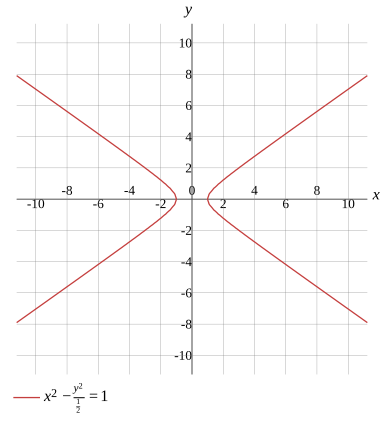Question
Identify the conic
Find the standard equation of the hyperbola
Find the center of the hyperbola
Find the foci of the hyperbola
Load more

x2−21y2=1
Evaluate
x2−2y2=1
Solution
x2−21y2=1
Show Solution

Solve the equation
Solve for x
Solve for y
x=1+2y2x=−1+2y2
Evaluate
x2−2y2=1
Move the expression to the right-hand side and change its sign
x2=1+2y2
Take the root of both sides of the equation and remember to use both positive and negative roots
x=±1+2y2
Solution
x=1+2y2x=−1+2y2
Show Solution

Testing for symmetry
Testing for symmetry about the origin
Testing for symmetry about the x-axis
Testing for symmetry about the y-axis
Symmetry with respect to the origin
Evaluate
x2−2y2=1
To test if the graph of x2−2y2=1 is symmetry with respect to the origin,substitute -x for x and -y for y
(−x)2−2(−y)2=1
Evaluate
More Steps


Evaluate
(−x)2−2(−y)2
Multiply the terms
(−x)2−2y2
Rewrite the expression
x2−2y2
x2−2y2=1
Solution
Symmetry with respect to the origin
Show Solution

Find the first derivative
Find the derivative with respect to x
Find the derivative with respect to y
dxdy=2yx
Calculate
x2−2y2=1
Take the derivative of both sides
dxd(x2−2y2)=dxd(1)
Calculate the derivative
More Steps


Evaluate
dxd(x2−2y2)
Use differentiation rules
dxd(x2)+dxd(−2y2)
Use dxdxn=nxn−1 to find derivative
2x+dxd(−2y2)
Evaluate the derivative
More Steps


Evaluate
dxd(−2y2)
Use differentiation rules
dyd(−2y2)×dxdy
Evaluate the derivative
−4ydxdy
2x−4ydxdy
2x−4ydxdy=dxd(1)
Calculate the derivative
2x−4ydxdy=0
Move the expression to the right-hand side and change its sign
−4ydxdy=0−2x
Removing 0 doesn't change the value,so remove it from the expression
−4ydxdy=−2x
Divide both sides
−4y−4ydxdy=−4y−2x
Divide the numbers
dxdy=−4y−2x
Solution
dxdy=2yx
Show Solution

Find the second derivative
Find the second derivative with respect to x
Find the second derivative with respect to y
dx2d2y=4y32y2−x2
Calculate
x2−2y2=1
Take the derivative of both sides
dxd(x2−2y2)=dxd(1)
Calculate the derivative
More Steps


Evaluate
dxd(x2−2y2)
Use differentiation rules
dxd(x2)+dxd(−2y2)
Use dxdxn=nxn−1 to find derivative
2x+dxd(−2y2)
Evaluate the derivative
More Steps


Evaluate
dxd(−2y2)
Use differentiation rules
dyd(−2y2)×dxdy
Evaluate the derivative
−4ydxdy
2x−4ydxdy
2x−4ydxdy=dxd(1)
Calculate the derivative
2x−4ydxdy=0
Move the expression to the right-hand side and change its sign
−4ydxdy=0−2x
Removing 0 doesn't change the value,so remove it from the expression
−4ydxdy=−2x
Divide both sides
−4y−4ydxdy=−4y−2x
Divide the numbers
dxdy=−4y−2x
Cancel out the common factor −2
dxdy=2yx
Take the derivative of both sides
dxd(dxdy)=dxd(2yx)
Calculate the derivative
dx2d2y=dxd(2yx)
Use differentiation rules
dx2d2y=(2y)2dxd(x)×2y−x×dxd(2y)
Use dxdxn=nxn−1 to find derivative
dx2d2y=(2y)21×2y−x×dxd(2y)
Calculate the derivative
More Steps


Evaluate
dxd(2y)
Simplify
2×dxd(y)
Calculate
2dxdy
dx2d2y=(2y)21×2y−x×2dxdy
Any expression multiplied by 1 remains the same
dx2d2y=(2y)22y−x×2dxdy
Use the commutative property to reorder the terms
dx2d2y=(2y)22y−2xdxdy
Calculate
More Steps


Evaluate
(2y)2
Evaluate the power
22y2
Evaluate the power
4y2
dx2d2y=4y22y−2xdxdy
Calculate
dx2d2y=2y2y−xdxdy
Use equation dxdy=2yx to substitute
dx2d2y=2y2y−x×2yx
Solution
More Steps


Calculate
2y2y−x×2yx
Multiply the terms
More Steps


Multiply the terms
x×2yx
Multiply the terms
2yx×x
Multiply the terms
2yx2
2y2y−2yx2
Subtract the terms
More Steps


Simplify
y−2yx2
Reduce fractions to a common denominator
2yy×2y−2yx2
Write all numerators above the common denominator
2yy×2y−x2
Multiply the terms
2y2y2−x2
2y22y2y2−x2
Multiply by the reciprocal
2y2y2−x2×2y21
Multiply the terms
2y×2y22y2−x2
Multiply the terms
More Steps


Evaluate
2y×2y2
Multiply the numbers
4y×y2
Multiply the terms
4y3
4y32y2−x2
dx2d2y=4y32y2−x2
Show Solution

Rewrite the equation
r=∣3cos2(θ)−2∣3cos2(θ)−2r=−∣3cos2(θ)−2∣3cos2(θ)−2
Evaluate
x2−2y2=1
To convert the equation to polar coordinates,substitute x for rcos(θ) and y for rsin(θ)
(cos(θ)×r)2−2(sin(θ)×r)2=1
Factor the expression
(cos2(θ)−2sin2(θ))r2=1
Simplify the expression
(3cos2(θ)−2)r2=1
Divide the terms
r2=3cos2(θ)−21
Evaluate the power
r=±3cos2(θ)−21
Simplify the expression
More Steps


Evaluate
3cos2(θ)−21
To take a root of a fraction,take the root of the numerator and denominator separately
3cos2(θ)−21
Multiply by the Conjugate
3cos2(θ)−2×3cos2(θ)−21×3cos2(θ)−2
Calculate
∣3cos2(θ)−2∣1×3cos2(θ)−2
Any expression multiplied by 1 remains the same
∣3cos2(θ)−2∣3cos2(θ)−2
r=±∣3cos2(θ)−2∣3cos2(θ)−2
Solution
r=∣3cos2(θ)−2∣3cos2(θ)−2r=−∣3cos2(θ)−2∣3cos2(θ)−2
Show Solution

Graph
